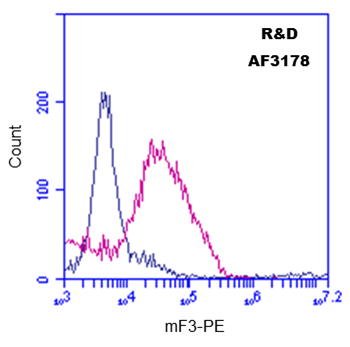Mouse Coagulation Factor III/Tissue Factor Antibody
Mouse Coagulation Factor III/Tissue Factor Antibody Summary
Ala29-Glu251
Accession # P20352
Applications
Please Note: Optimal dilutions should be determined by each laboratory for each application. General Protocols are available in the Technical Information section on our website.
Reconstitution Calculator
Preparation and Storage
- 12 months from date of receipt, -20 to -70 °C as supplied.
- 1 month, 2 to 8 °C under sterile conditions after reconstitution.
- 6 months, -20 to -70 °C under sterile conditions after reconstitution.
Background: Coagulation Factor III/Tissue Factor
Coagulation Factor III/Tissue Factor (TF), also known as thromboplastin and CD142, is an integral membrane protein found in a variety of cell types. It functions as a protein cofactor/receptor of Coagulation Factor VII, which is synthesized in the liver and circulated in the plasma (1). Upon binding of TF, the inactive factor VII is rapidly converted into activated VIIa. The resulting 1:1 complex of VIIa and TF initiates the coagulation pathway and has also important coagulation-independent functions such as angiognesis (2). Synthesized as a 294 amino acid precursor, mouse TF consists of a signal peptide (residues 1-28) and the mature chain (residues 29-294). As a type I membrane protein, it contains a transmembrane region (residues 252-274) and a cytoplasmic tail (residues 275-294) (3, 4). The purified rmTF corresponds to the ectodomain (residues 29-251) and is potent in activating thermolysin-processed rmCoagulation Factor VII (R&D Systems, Catalog # 3305-SE) under the conditions described in the Activity Assay Protocol.
- Morrissey, J.H. (2004) in Handbook of Proteolytic Enzymes. Barrett, A.J. et al. (ed) Academic Press, San Diego, p. 1659.
- Versteeg, H.H. et al. (2003) Carcinogenesis 24:1009.
- Ranganathan, G. et al. (1991) J. Biol. Chem. 266:496.
- Hartzell, S. (1989) Mol. Cell. Biol. 9:2567.
Product Datasheets
Citations for Mouse Coagulation Factor III/Tissue Factor Antibody
R&D Systems personnel manually curate a database that contains references using R&D Systems products. The data collected includes not only links to publications in PubMed, but also provides information about sample types, species, and experimental conditions.
6
Citations: Showing 1 - 6
Filter your results:
Filter by:
-
Aging impairs cold-induced beige adipogenesis and adipocyte metabolic reprogramming
Authors: CD Holman, AP Sakers, RP Calhoun, L Cheng, EC Fein, C Jacobs, L Tsai, ED Rosen, P Seale
bioRxiv : the preprint server for biology, 2023-03-23;0(0):.
Species: Mouse
Sample Types: Whole Cells
Applications: Flow Cytometry -
SENP3 in monocytes/macrophages up-regulates tissue factor and mediates lipopolysaccharide-induced acute lung injury by enhancing JNK phosphorylation
Authors: X Chen, Y Lao, J Yi, J Yang, S He, Y Chen
J. Cell. Mol. Med., 2020-03-31;0(0):.
Species: Mouse
Sample Types: Tissue Lysate
Applications: Western Blot -
Protease-activated receptor 2 protects against VEGF inhibitor-induced glomerular endothelial and podocyte injury
Authors: Y Oe, T Fushima, E Sato, A Sekimoto, K Kisu, H Sato, J Sugawara, S Ito, N Takahashi
Sci Rep, 2019-02-27;9(1):2986.
Species: Mouse
Sample Types: Whole Tissue
Applications: IHC-P -
The Myosin II Inhibitor, Blebbistatin, Ameliorates FeCl3-induced Arterial Thrombosis via the GSK3?-NF-?B Pathway
Authors: Y Zhang, L Li, Y Zhao, H Han, Y Hu, D Liang, B Yu, J Kou
Int. J. Biol. Sci., 2017-05-15;13(5):630-639.
Species: Mouse
Sample Types: Whole Tissue
Applications: IHC -
Mechanical stretch inhibits lipopolysaccharide-induced keratinocyte-derived chemokine and tissue factor expression while increasing procoagulant activity in murine lung epithelial cells.
Authors: Sebag S, Bastarache J, Ware L
J Biol Chem, 2013-01-29;288(11):7875-84.
Species: Mouse
Sample Types: Cell Lysates
Applications: Western Blot -
Elevated tissue factor expression contributes to exacerbated diabetic nephropathy in mice lacking eNOS fed a high fat diet.
Authors: Li F, Wang CH, Wang JG, Thai T, Boysen G, Xu L, Turner AL, Wolberg AS, Mackman N, Maeda N, Takahashi N
J. Thromb. Haemost., 2010-10-01;8(10):2122-32.
Species: Mouse
Sample Types: In Vivo
Applications: Neutralization
FAQs
No product specific FAQs exist for this product, however you may
View all Antibody FAQsReviews for Mouse Coagulation Factor III/Tissue Factor Antibody
Average Rating: 5 (Based on 4 Reviews)
Have you used Mouse Coagulation Factor III/Tissue Factor Antibody?
Submit a review and receive an Amazon gift card.
$25/€18/£15/$25CAN/¥75 Yuan/¥2500 Yen for a review with an image
$10/€7/£6/$10 CAD/¥70 Yuan/¥1110 Yen for a review without an image
Filter by:
This protein might be found in high levels in some conditions/tissues. If you calibrate a good concentration you will have a nice band around 50 KDa
Used as detection antibody after labeling with Sulfo-Tag according to manufacturer's protocol (Meso Scale Diagnostics LLC)
Detection range - 8-30,000 pg/ml
Detection of Coagulation Factor III in Mouse mononuclear cells using Goat anti-Mouse F3 antibody (#AF3178, pink) at 2.5 ug/10^6 cells, or Isotype Control IgG (blue), followed by PE-conjugated anti-Goat secondary antibody.






